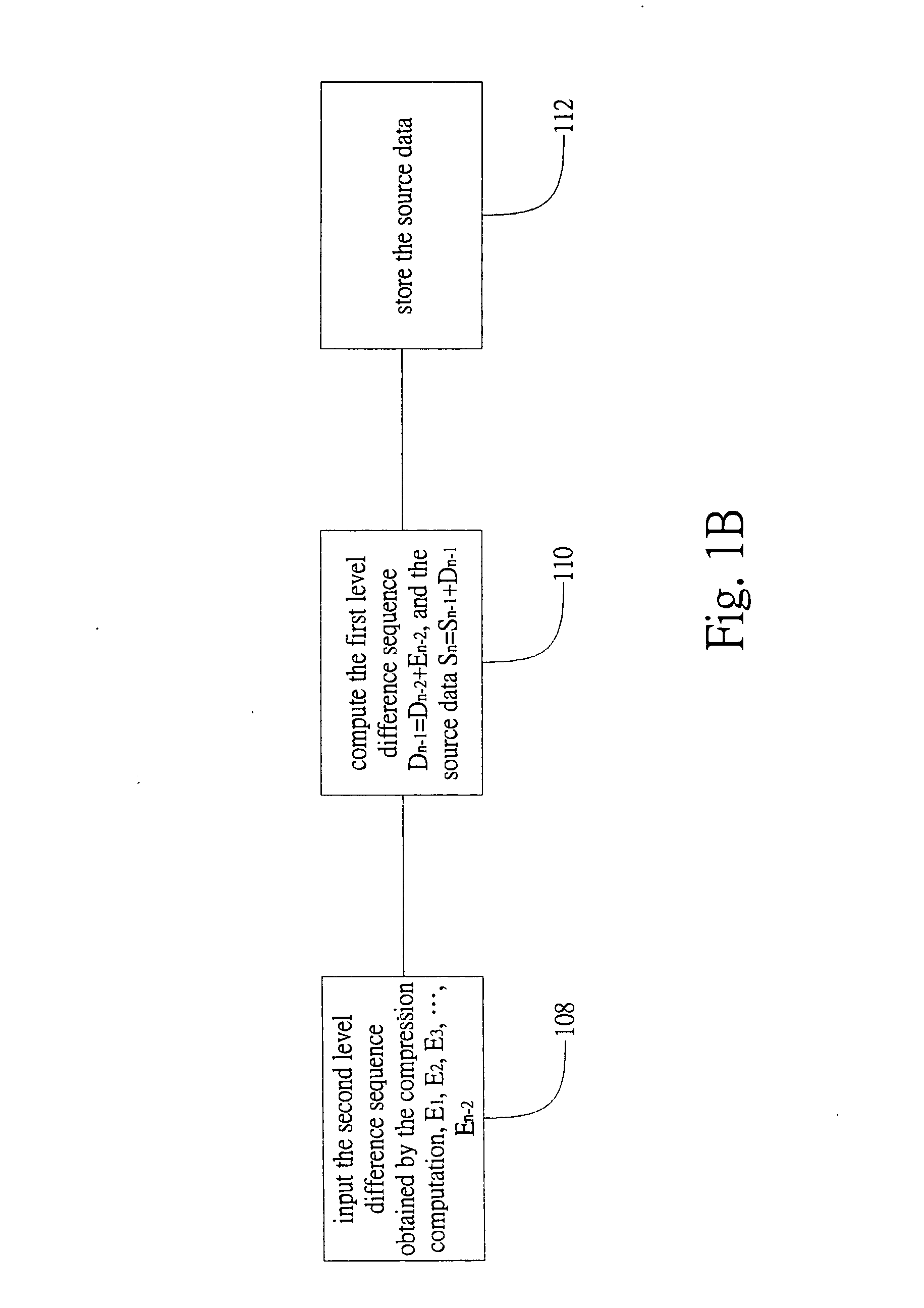Method for compressing audio data
a data stream and audio technology, applied in the field of audio data compression, can solve the problems of large amount of data transported through the network and stored in recording media, requiring heavy investment, and inability to compress certain types of data, such as audio data, and processors spend a lot of effort in determining the length of difference of each sample segment, so as to improve compression and decompression efficiency, reduce data, and increase the compression ratio
- Summary
- Abstract
- Description
- Claims
- Application Information
AI Technical Summary
Benefits of technology
Problems solved by technology
Method used
Image
Examples
first embodiment
[0027] With reference to the drawings and in particular to FIGS. 1A and 1B, which show flowcharts of encoding and decoding of a compression method in accordance with the present invention. As shown in FIG. 1A, step 102 is to input source data, S1, S2, S3, . . . , Sn-2, Sn-1, Sn. Step 104 is to generate the first level difference Dn-1=Sn−Sn-1, and the second level difference En-2=Dn-1−Dn-2. Repeat the above computation to obtain the following sequences:
[0028] First level difference sequence: D1=S2−S1, D2=S3−S2, . . . , Dn-1=Sn−Sn-1;
[0029] Second level difference sequence: E1=D2−D1, E2=D3−D2, . . . , En-2=Dn-1−Dn-2.
And finally, step 106 is to store the second level difference sequence.
[0030] The decompression computation follows the reverse direction. As shown in FIG. 1B, step 108 is to input the second level difference sequence obtained by the compression computation, E1, E2, E3, . . . , En-2. Step 110 is to compute the first level difference sequence Dn-1=Dn-2+En-2, and the sour...
second embodiment
[0033]FIGS. 2A and 2B show flowcharts of encoding and decoding of a compression method in accordance with the present invention. By utilizing the inter-dependency between the consecutive samples, this embodiment estimates the next sample linearly based on previous two consecutive samples, and obtains the difference between the estimation and the actual vale so as to reduce the number of bits required for data.
[0034] As shown in FIG. 2A, step 202 is to input source data, S1, S2, S3, . . . , Sn-2, Sn-1, Sn. Step 204 is to use two consecutive samples to generate the linear estimation for the next sample Pn=2×Sn-2−Sn-1, and the sequence. Then, step 206 is to subtract the linear estimation from the actual value, and obtain a linear estimation difference Dn=Sn−Pn. Repeat the above computation to obtain the following sequences:
[0035] Linear estimation sequence: P3=2×S2−S1, P4=2×S3−S2, . . . , Pn=2×Sn-2−Sn-1;
[0036] Linear estimation difference sequence: D3=S3−P3, D4=S4−P4, . . . , Dn=Sn−P...
third embodiment
[0040]FIGS. 3A and 3B show flowcharts of encoding and decoding of a compression method in accordance with the present invention. By utilizing the inter-dependency between the consecutive samples, this embodiment estimates the sample based on one prior sample and one next sample, and obtains the difference between the estimation and the actual vale.
[0041] As shown in FIG. 3A, step 302 is to input source data, S1, S2, S3, . . . , Sn-2, Sn-1, Sn. Step 304 is to use one prior sample and one next sample to generate the average estimation for the sample An-1=(Sn-2+Sn) / 2, and the sequence. Then, step 306 is to subtract the estimation from the actual value, and obtain an average estimation difference Dn=Sn−An. Repeat the above computation to obtain the following sequences:
[0042] Average estimation sequence: A2=(S1+S3) / 2, A3=(S2+S4) / 2, . . . , An-1=(Sn-2+Sn) / 2;
[0043] Average estimation difference sequence: D2=S2−A2, D3=S3−A3, . . . , Dn-1=Sn-1−An-1.
And finally, step 306 is to store the a...
PUM
 Login to View More
Login to View More Abstract
Description
Claims
Application Information
 Login to View More
Login to View More - R&D
- Intellectual Property
- Life Sciences
- Materials
- Tech Scout
- Unparalleled Data Quality
- Higher Quality Content
- 60% Fewer Hallucinations
Browse by: Latest US Patents, China's latest patents, Technical Efficacy Thesaurus, Application Domain, Technology Topic, Popular Technical Reports.
© 2025 PatSnap. All rights reserved.Legal|Privacy policy|Modern Slavery Act Transparency Statement|Sitemap|About US| Contact US: help@patsnap.com



